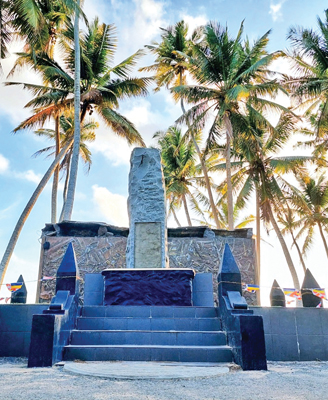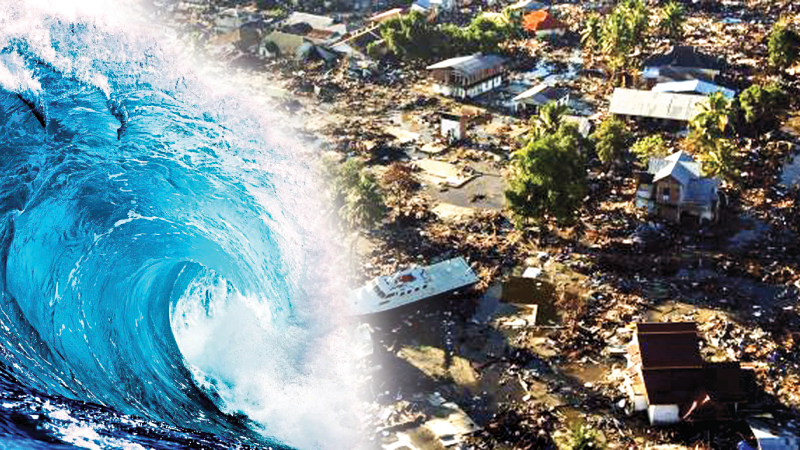 Where were you at 9.36 a.m. on December 26, 2004? That has become one of the definitive questions such as “where were you on November 22 1963 when John F. Kennedy was shot?”. It is a moment that we will all remember, as long as we live. Indeed, the Indian Ocean tsunami is the most catastrophic event in living memory for many of us. And we are on the cusp of marking 20 years since that fateful day, which saw the deaths of nearly 240,000 people across 14 countries in Asia and Africa.
Where were you at 9.36 a.m. on December 26, 2004? That has become one of the definitive questions such as “where were you on November 22 1963 when John F. Kennedy was shot?”. It is a moment that we will all remember, as long as we live. Indeed, the Indian Ocean tsunami is the most catastrophic event in living memory for many of us. And we are on the cusp of marking 20 years since that fateful day, which saw the deaths of nearly 240,000 people across 14 countries in Asia and Africa.
But at that exact time, no one in Sri Lanka (and I believe most other countries) knew what was about to happen. The very word tsunami was unknown to 99 percent of the population. I, for one, knew what it meant but never in my wildest dreams did I imagine that I would see the devastating effects of a tsunami in Sri Lanka itself.
It was a harrowing day that simply has no parallel, even for a country such as Sri Lanka which had suffered immensely due to a protracted terrorist conflict. Triggered by a 9.3 undersea quake that literally shook the Earth, the tsunami swept through coastal towns in the Indian Ocean Region (IOR) reducing them virtually to cinders.
Worst affected
Indonesia was the worst affected country (128,000 deaths) and Sri Lanka was the second in line, with nearly 40,000 deaths island-wide.
Just what is a tsunami? Tsunami is a Japanese word comprising the words “tsu” (meaning harbour) and “nami” (meaning wave). It is not surprising that this word has originated in Japan, considering the frequency of tsunamis there.
A tsunami is a series of enormous waves created by an underwater disturbance usually associated with earthquakes occurring below or near the ocean. Volcanic eruptions (like the one in Indonesia caused by the “Son of Krakatoa”), submarine landslides, and coastal rock falls can also generate a tsunami, as can a large asteroid impacting the ocean (as depicted in movies such as Deep Impact).
Tsunamis originate from a vertical movement of the sea floor with the consequent displacement of water mass. Tsunami waves often look like walls of water and can attack the shoreline and be dangerous for hours, with waves coming every 5 to 60 minutes. The first wave may not be the largest, and often it is the 2nd, 3rd, 4th waves that are the biggest.
Tsunamis are rare events, but they can be extremely deadly. In the past 100 years, 58 tsunamis have claimed more than 260,000 lives, or an average of 4,600 per disaster, surpassing any other natural hazard. The highest number of deaths in that period was in the Indian Ocean tsunami of December 26, 2004. Hence the name Boxing Day Tsunami.
The word – as well as the phenomenon – was etched deeply in the collective conscience of a nation on that tragic day. Ever since, the mere mention of the word is enough to instill fear in our minds.
There have been several tsunamis in other parts of the world since then, most noticeably Japan (March 11, 2011), but nothing could come close to the sheer scale of death and destruction caused by the Indian Ocean tsunami of December 26, 2004.
 Asia has received a state-of-the-art tsunami warning system with active and passive safety features while emergency services have been geared to inform and evacuate coastal dwellers as fast as possible. With almost everyone having a cellular phone, sending a warning text has become a very effective approach.
Asia has received a state-of-the-art tsunami warning system with active and passive safety features while emergency services have been geared to inform and evacuate coastal dwellers as fast as possible. With almost everyone having a cellular phone, sending a warning text has become a very effective approach.
Yet, we have still not reached perfection in this regard. Two decades after the Indian Ocean tsunami struck, the Asia-Pacific region remains highly disaster prone and critical gaps remain in early warning, especially in reaching the most vulnerable people and remote communities.
There have been warnings that 20 years after the Boxing Day tsunami, a degree of complacency has set in to the detection and early warning process, which should not be the case.
Just three weeks after the Boxing Day Tsunami, the international community came together in Kobe, in Japan’s Hyogo region. Governments around the world adopted the 10-year Hyogo Framework for Action, the first comprehensive global agreement on disaster risk reduction.
They also created the Indian Ocean Tsunami warning and Mitigation System which boasts scores of seismographic and sea-level monitoring stations and disseminates alerts to national tsunami information centres. Rapid urbanisation and growing tourism in tsunami-prone regions are putting ever-more people in harm’s way.
That makes the reduction of risk a key factor if the world is to achieve substantial reductions in disaster mortality – a primary goal of the Sendai Framework, the 15-year international agreement adopted in March 2015 to succeed the Hyogo Framework.
In retrospect, there is enough awareness about tsunamis now. People generally know what to do and how to behave in an impending tsunami situation without even being told. What has not been really tested is our state of readiness, including the functionality of the tsunami alert system.
Several drills
Although several drills have been held from time to time, we do not know how the systems will behave collectively in a real-life tsunami crisis. For example, will a tsunami alert text message be delivered to 21 million phones in a matter of minutes? Sending a text to 20 million phones may not be as simple as it sounds – any quake could bring down power and communications lines, thus affecting mobile coverage.
Another worrying factor is that critical components of the expensive early warning system may not be working properly due to natural damage and even vandalism. The third factor, which is common to most developing countries, is the lack of a maintenance budget for systems such as these. Sri Lankan authorities must urgently assess the operational capability and readiness of the early warning system. Any Budgetary constraints must be immediately addressed regardless of the costs involved.
But earthquakes and seaquakes are fast events and sometimes coastal dwellers may have just 15 minutes’ warning to reach higher ground. In fact, UNESCO’s Intergovernmental Oceanographic Commission met in February 2009 in Apia, Samoa, to help raise public awareness that, in the worst-case scenario, villagers would get just 15 minutes of warning before a tsunami struck. That was “our number one point made: You have only 15 minutes. Remember that number,” said a UNESCO spokesperson.
Intensify research
The Indian Ocean countries and Japan must thus intensify research on earthquakes and tsunamis and collaborate more closely with well-known bodies such as the US Geological Survey (USGS).
We must also be wary of Climate Change which can cause low-lying cities to go underwater. There will be a greater threat of landslide tsunamis as some melting glacial mountains can topple into the sea, generating massive tsunamis. With a wave run-up of nearly 200 metres, the tsunami that ripped through an Alaskan fjord in 2015 was one of the largest ever documented. But with no-one killed, it almost went unnoticed. It was triggered by a massive rockfall caused by melting of the Tyndall Glacier, which experts say has given them the clearest picture to date of a landslide generated tsunami.
Accurate earthquake prediction remains the Holy Grail of scientists. Forecasting an earthquake’s approximate date assumes earthquakes follow some kind of pattern — that faults release pressure in a predictable way. It is difficult to find a rhythm to earthquakes, even though the last major tsunami in Asia prior to 2004 had occurred probably in 1300-1400 AD. Indeed, a big undersea quake can happen tomorrow or in another 1,000 years.
 Unlike us, animals seem to be having a “sixth sense” that can give them an indication of an impending disaster, well before any of our advanced gadgets. In fact, no animals perished in the 2004 tsunami except those who were tied or caged.
Unlike us, animals seem to be having a “sixth sense” that can give them an indication of an impending disaster, well before any of our advanced gadgets. In fact, no animals perished in the 2004 tsunami except those who were tied or caged.
Humans have lost this sense in the course of evolution, so we have to rely on technology instead. There is the possibility of using Artificial Intelligence (AI), somewhat akin to the animals’ sixth sense, to predict earthquakes at least a few minutes in advance. We hope these efforts succeed, because that would mean more lives can be saved.
Tsunamis are unpredictable, but armed with more knowledge and better warning systems, we will be able to minimise any loss of life and property if and when a major tsunami strikes. The good news is that there are 75 high-tech DART (Deep-ocean Assessment and Reporting of Tsunamis) bouys in oceans around the world, covering every coastline.
In 2004, just one sea level station was monitoring the Indian Ocean. Today, there are some 1,400 stations delivering real-time sea-surface height data in that ocean basin, which aid in forecasts not just for tsunamis, but also for cyclone-related storm surges. Faster supercomputers are aiding in speeding up warning systems, in hopes of adding a few more precious minutes for people to get to safety. Seismic analyses that took five to six minutes in 2004 now take just a minute or so.
Sea level assessments that in 2004 might have taken hours have dropped to about an hour or less — thanks not just to hundreds more stations measuring sea level, but also to the speed of data transmission. In 2004, most sea level stations transmitted data once an hour and sampled sea-surface heights every six minutes. Now it takes a fraction of the time to track swift changes in sea level, with stations measuring sea-surface heights every minute and uploading those data every five minutes.
Technology aside, are we prepared for another such event? It is very difficult to get shattered lives back on track – what do you say to a little girl who had lost her entire family to the raging waves? To parents who lost all their children? A personal tragedy on that scale is hard to fathom and bear at any age. We have to be one with them as we remember all those who perished that morning as a ferocious sea engulfed the land.
The tsunami also shattered the myth that Sri Lanka and surrounding countries were “safe” from earthquakes or undersea quakes.
Now that we know the power and fury of the ocean, the damage it could do, subliminally we will always fear and respect it.
On the other hand, the ocean is central to our lives as islanders. It is a resource we cannot do without. It is an equation that we will have to live with for the rest of our lives. We may obliterate all physical traces of the tsunami, but it is not so easy to heal the mental scars of thousands of people who had lost everything they cherished – their loved ones, their belongings and their houses.
While tsunami affected people can be provided with jobs and houses, there will always be those who cannot come to terms with their loss. There must be a mechanism to deal with this kind of psychological emergency. The response to a tsunami should be multifaceted and swift. But let’s hope that we never have to face a tsunami again.






